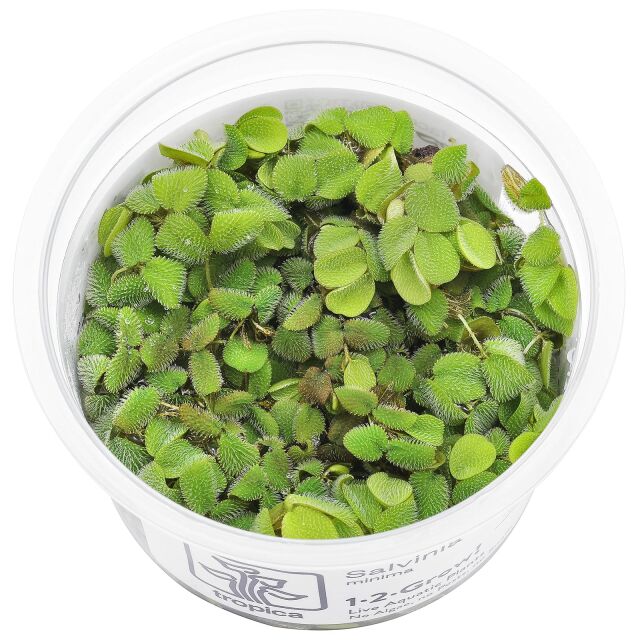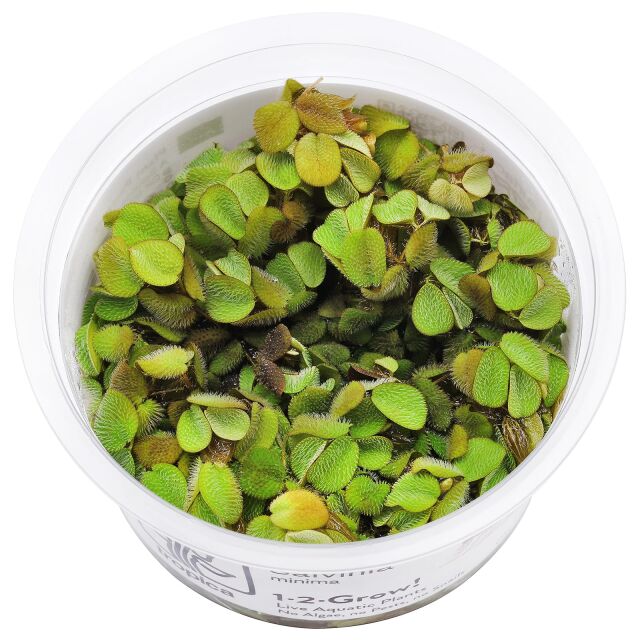Common Salvinia



Salvinia minima
Common Salvinia
- Undemanding floater
- Fast-growing
- Small, roundish leaves
- Recommendable for breeding tanks
Item question
We’re here for you!
Please enter your question and e-mail and we’ll contact you as soon as possible. It usually takes us up to 24 hours during business days to respond.
Thank you for your question!
Thank you, we’ll get in touch!
Close window
You already sent us a question.
Please wait a few minutes
Description
The Common Salvinia is native to tropical America and develops only 1 to 1.5 cm long, roundish floating leaves. It stays considerably smaller than Salvinia auriculata.
Salvinia minima is a versatile floating plant, having only little demands and growing also under moderate lighting. However it benefits much from nutrient-rich water.
With its fast growth, this small floating fern removes excess nutrients from the water column and is useful for breeding tanks. Its small size makes it suitable for small, open tanks and the water part of paludariums and ripariums.
Salvinia minima is a small floating fern originating from the American tropics. It has been introduced into the south of the US, where it is considered an invasive aquatic weed.
This floating fern, like other Salvinia species, forms floating mats on the surface of different, mostly stagnant waters.
The floating leaves of S. minima are roundish to broad-oval, have a heart-shaped basis and grow to a length of 1 to 1.5 cm. Under unfavourable conditions they tend to stay smaller, however. The stems branch out and grow to a length of around 10 cm before they break, forming new plants.
The hairs on the leaf surface most frequently form groups of four, and their tips are not connected (magnifying glass). This is an easy way to discern Salvinia minima from S. molesta and other species of the group of plants related to Salvinia auriculata. (read more)
| Common names | Common Salvinia, Water spangles |
| Misapplied names | Salvinia natans, Salvinia rotundifolia |
| Complete botanical name | Salvínia mínima Baker |
| Family | Salviniaceae |
| Genus | Salvinia |
| Difficulty | easy |
| Usage | Water surface |
| Growth | very fast |
| pH value | 5 - 8 |
| Temperature tolerance | 18 - 32°C |
| Carbonate hardness | 0 - 21°dKH |
| General hardness | 0 - 30°dGH |
| Propagation | Fragmentation, Splitting, cutting off daughter plants |
| Can grow emersed? | no |
| Source | Flowgrow |
| Common names |
| Common Salvinia, Water spangles |
| Misapplied names |
| Salvinia natans, Salvinia rotundifolia |
| Complete botanical name |
| Salvínia mínima Baker |
| Family |
| Salviniaceae |
| Genus |
| Salvinia |
| Difficulty |
| easy |
| Usage |
| Water surface |
| Growth |
| very fast |
| pH value |
| 5 - 8 |
| Temperature tolerance |
| 18 - 32°C |
| Carbonate hardness |
| 0 - 21°dKH |
| General hardness |
| 0 - 30°dGH |
| Propagation |
| Fragmentation, Splitting, cutting off daughter plants |
| Can grow emersed? |
| no |
| Source |
| Flowgrow |
How many plants do I need?
General information
Please choose a variant to see more information.
| Item no. |
|
| EAN | |
| Weight | |
| Shipping weight |
Customers ask customers
You have questions about this product? Ask other customer or our support team about this product!
Customer reviews
One review
| 5 Stars(1) |
|
| 4 Stars(0) |
|
| 3 Stars(0) |
|
| 2 Stars(0) |
|
| 1 Star(0) |
|

Good portion, nice healthy plant with long roots, quick delivery. My expectations were met, now my little fish have some hiding spots